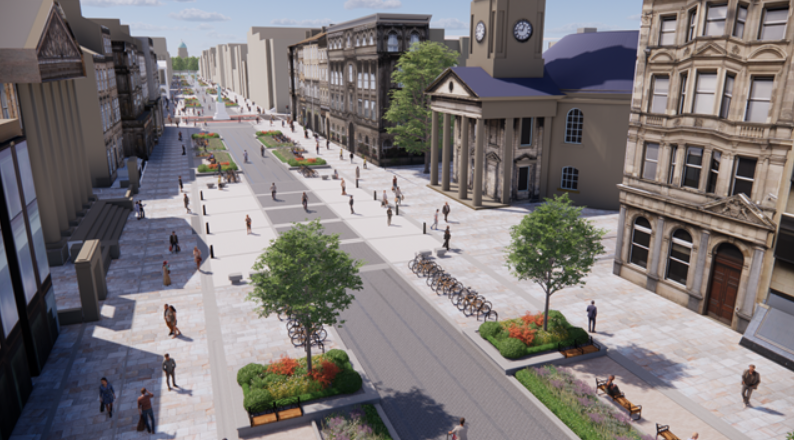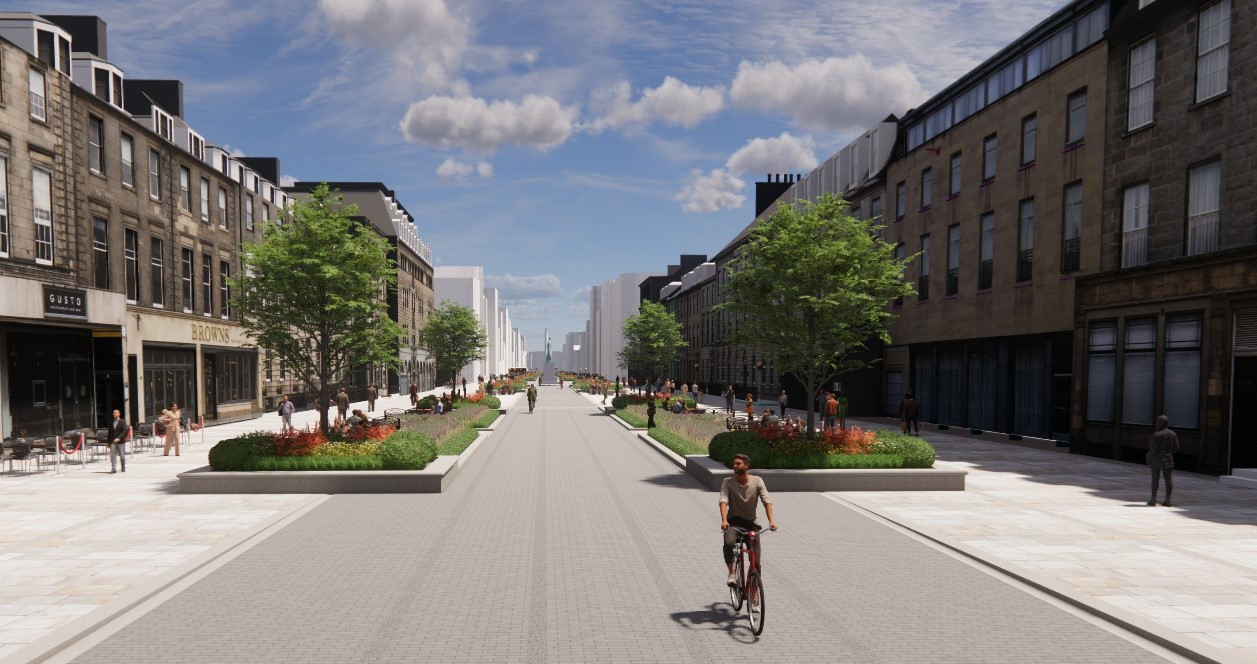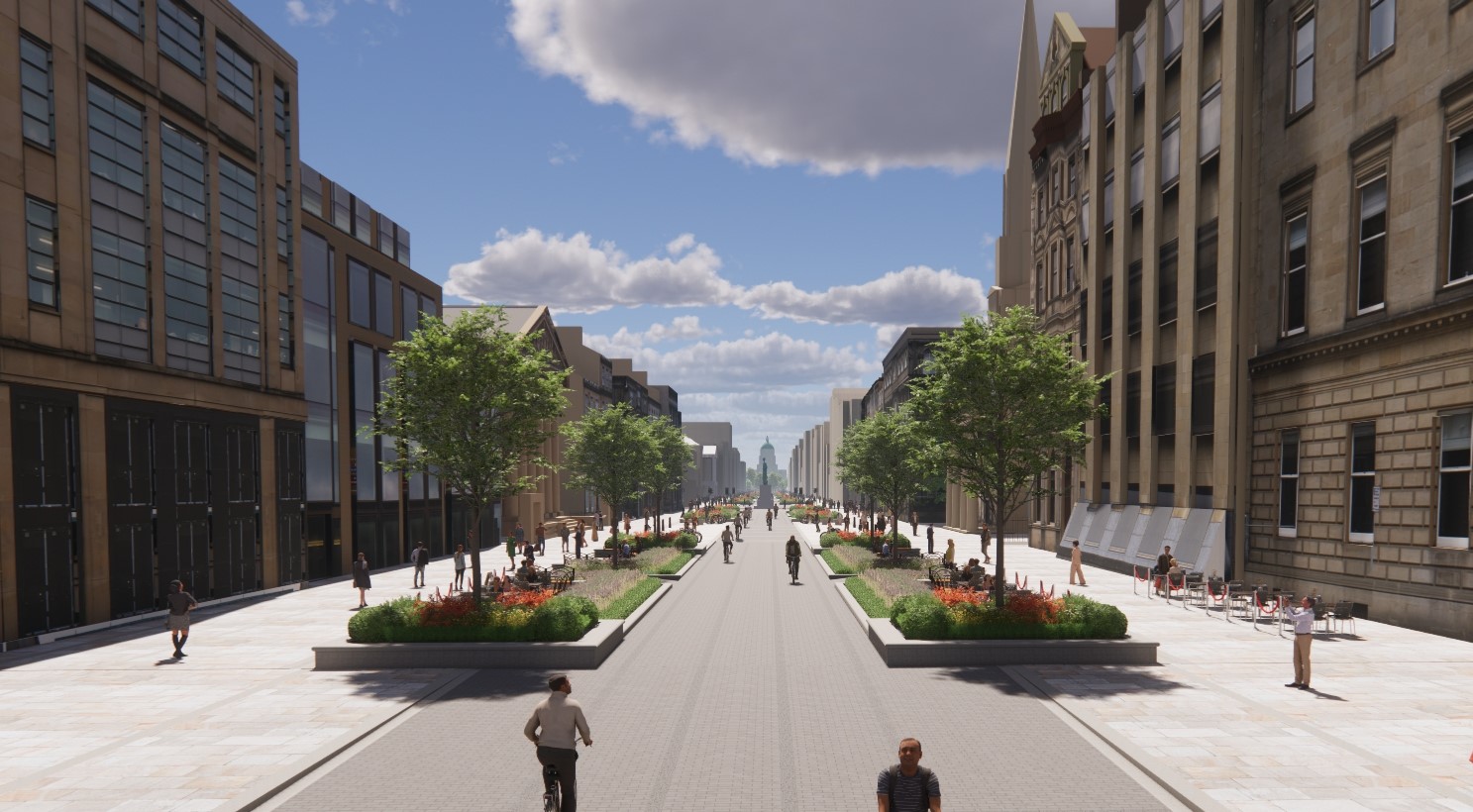Edinburgh unveils updated George Street and First New Town project designs

How George Street would look from above
A final operational plan for Edinburgh’s George Street and First New Town (GNT) project was approved by members of the Transport and Environment Committee yesterday along with updates to the proposed design.
A key change is the introduction of trees on George Street, which has been agreed following discussions with Edinburgh World Heritage, Historic Environment Scotland, the Cockburn Association and other stakeholders.
This recognises trees’ contribution to the city’s Net Zero 2030 goals as well as their capacity to enhance the street’s biodiversity value, helping to combat urban heat island effects and supporting its One Million Tree City pledge. Following the approval of proposals, the council will continue to work closely with partners to determine the appropriate position, number and type of trees to be added.
Committee members approved updates to the principles of the proposed GNT Operational Plan which include plans for the creation of a pedestrian and cycling zone where loading, servicing and licensed taxi access on George Street will only be permitted during evening and morning hours. At this stage, automated bollards will provide additional public safety measures and enforce the pedestrian cycling zone restrictions. Blue badge holders will still be able to park in disabled bays on George Street and the surrounding streets.
The George Street and First New Town project is being supported by funding from the Scottish Government through Sustrans Scotland’s Places for Everyone programme and delivered by the City of Edinburgh Council.
Councillor Scott Arthur, Transport and Environment convener, said: “In updating designs and operational plans for the GNT project, the project team has worked closely with the community, key stakeholders and elected members to develop proposals which will both enhance the space for all those travelling through and spending time in the area but also retain the First New Town’s unique historic value.

Looking east along George Street from Charlotte Square
“I know the potential inclusion of trees on George Street will be welcomed by many, now their inclusion has been approved more work will be done to ensure the position and type of trees is sympathetic to the street’s iconic character.
“We have also listened carefully to the Edinburgh Access Panel and have agreed blue badge holders should have full access to up to 27 blue badge spaces in the George Street and First New Town area.
“This latest update marks an exciting milestone in the GNT project and it will allow us to move forward with the final stages of development before construction begins.”
Minister for active travel, Patrick Harvie, said: “I welcome the latest approved designs for the George Street and First New Town project. With over £13 million being invested by the Scottish Government, the introduction of more trees alongside improved walking, wheeling and cycling infrastructure will create a more pleasant environment for people to enjoy.
“This work, supported by Sustrans Scotland, is part of our record funding for active travel in 2023/24 and we remain committed to investing at least £320 million or 10% of the transport budget for active travel by 2024/25.”
Royal Institute of British Architects (RIBA) Stage 3 developed design principles were approved in November 2022, though these were conditional upon further discussions around factors such as the potential inclusion of trees and taxi access.

Looking west along George Street from St Andrew Square
Amongst the ‘core elements’ of the design are significantly widened pavements, the creation of a European-style cycling street and the removal of parking bays (while retaining blue badge parking). The First New Town operation plan will support the area’s transformation and, in addition to setting out taxi access and enforcement, the plan maintains bus services in the wider First New Town (Hanover, Frederick and North/South St David Street) and criteria for exempt vehicles.
The next stage for the project will be to progress the promotion of all the necessary statutory processes for George Street, which provide the powers to enable the construction of the project, scheduled for 2025. Further engagement and analysis will be carried out on planned layouts for Hanover, Frederick and Castle Street during the next design stage in the process, RIBA Stage 4.
Earlier this year the George Street and First New Town project was shortlisted in the Pineapple Awards, celebrate excellence in place-based design and development, and is in the running as a finalist for the Scottish Design Awards in the Master Planning category.
The report was approved with a series of addendums and amendments from groups. These include agreements to consider of the project’s impact on the wider Active Travel Investment Programme, to continue dialogue on licensed taxi access for people with disabilities and to explore how the plan can deliver priority for pedestrians, wheelers and cyclists while also ensuring accessibility for disabled people.
Simon Strain, head of Places for Everyone programme at Sustrans, said: “We are pleased to see the final operational plan for George Street and First New Town approved by members of the Transport and Environment Committee, along with updates to the proposed design.
“The funding awarded for this project will help make everyday walking, wheeling, and cycling journeys a reality, as well as improving biodiversity and creating a new space for people to spend time and relax in Edinburgh city centre.”
Stuart Hay, director at Living Streets Scotland, added: “Edinburgh is currently one of the least pedestrianised historic cities in Northern Europe, so we are delighted to see progress in the plans for a place that prioritises people, not cars. George Street has the potential to become the heart of the city, creating a much-needed public space of high quality.”























